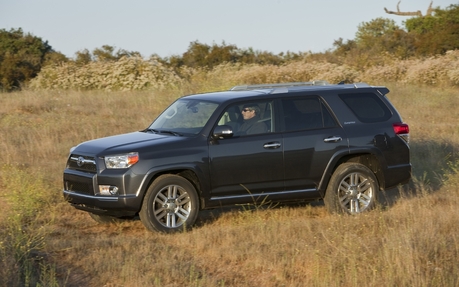2012 Toyota 4Runner: Demonstrably Different
I know a lot of people with 4Runners. As a young man, with young man friends, the 4Runner's combination of practicality and capability makes them perfect for silly pursuits like fishing, shooting, and camping, and their larger interiors and fixed roofs can be a real boon in the wet Pacific Northwest, should your tent spring a leak. But there's another reason they've been so damn popular: customization. With an aftermarket that rivals that of its biggest rival, the immortal Jeep, the 4Runner's massive level of aftermarket support ensures that young guys can build their Toyota to do precisely what they want it to, or at least look like it does. But the mainstream aftermarket's days are numbered, and the 4Runner is a perfect example of why.
Almost a year ago, I found myself crawling up a snowbound trail in a 4Runner Trail Edition. Equipped with everything from locking differentials to what I can best equate to off-road cruise control, its rollicking forward progress was only brought to a halt by the encroachment of the trailside alder and a lack of commitment on my part. A few months later, I found myself in another 4Runner, but the only rocking motion this one imparted was a dull swaying brought on by the Oak Street bridge's expansion joints. Trading the Trail Edition's Crawl Control for something called X-REAS Sport Suspension, the 4Runner Limited with Navigation didn't even look like the burly black-clad Trail Edition I remembered. Sporting colour-keyed trim, big wheels, chrome highlights, and a sleeker profile overall, it was every bit as civilized as the Trail Edition had been rugged.
And the theme continued within. With everything from keyless entry and push-button starting to voice-activated navigation and heated seats, it's cabin was the very picture of the modern, suburban-dwelling, well-appointed SUV. But if the Trail Edition's wide console and thick door tops seemed great for map unfolding and torso-propping, the Limited's seemed better utilized by Blackberry stowage and elbow-resting. Of course, many of the same features, such as the unique roll-down rear window and excellent dashboard layout went absolutely unchanged, and were just as welcome in this, the most luxurious of 4Runners, as they were in the most rugged.
But, for all its similarities and differences, perhaps the most telling aspect of the more luxurious 4Runner was its driving manners. While the Trail Edition felt like a longer wheelbase variant of the softly suspended FJ Cruiser, the Limited was more like a giant Camry. Still copiously soft over undulations and bumps, the Limited felt as if it's body movements responded to inputs in a much more controlled manner; gone was much of the dive, squat, and body roll of the off-road prepared model. Making it feel a bit more comfortable on the highway, the difference was best experienced in an urban setting, where the controlled motions led to a much more confident driving experience. Instead of pitching and rolling around every corner, the 4Runner simply rounded them, its street-biased tires and 20" wheels making everything feel that much more responsive. Add in the interior amenities and logically laid-out cabin, and it was amazing how well the 4Runner found itself at home in the crushing confines of the downtown setting.
So, what does any of this have to do with the aftermarket? Well, if Toyota can build a 4Runner that emulates the behaviour of their consistently inoffensive Camry upon the same chassis off which the well-prepared Trail Edition is spun, how much room is there for third party companies? Sure, there will always be the guys that want to push the envelope, and for them, there will always be suppliers of 44" tires, massive axles, and huge lifts. But given the vast majority of enthusiasts aren't looking for anything that extreme, it's hard to envision how the aftermarket can hope to go toe to toe with the massive development dollars companies like Toyota are now dedicating to the enthusiast market. And few vehicles demonstrate that better than the versatile 4Runner. Want a vehicle that you can throw a tent on top of and crawl into Canada's vast wilderness with? A 4Runner can do that. Want an SUV that you can take the kids skiing in, but still pick your boss up from the airport with? A 4Runner can do that. And best of all, although whichever model you pick will undoubtedly have its own strengths and weaknesses, they're all capable of doing at least a little bit of everything.
| Test drive report | |
| Test model | 2013 Toyota 4Runner |
|---|---|
| Trim level | SR5 Limited V6 |
| Price range | $36,935 – $49,780 |
| Price as tested | CA$49,780 |
| Warranty (basic) | 3 years/60,000 km |
| Warranty (powertrain) | 5 years/100,000 km |
| Fuel economy (city/highway/observed) | 17.0 / 23.0 / 14.6 L/100km |
| Options | N/A |
| Competitive models | Ford Explorer, Jeep Grand Cherokee, Nissan Pathfinder |
| Strong points |
|
| Weak points |
|
| Editor's rating | |
| Fuel economy | Pretty much middle of the road |
| Value | Although the 4Runner is a decent deal, the Limited comes with a hefty premium |
| Styling | Handsome, but it disappears in a crowd |
| Comfort | Soft, squishy, and plenty big enough to be comfortable for any length of time |
| Performance | How does one measure the performance of such a vehicle? |
| Overall | It's good... it's exactly what you expect... and in being so, doesn't break any new ground. |
